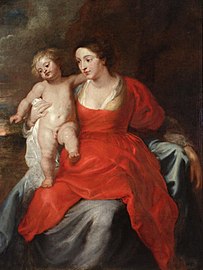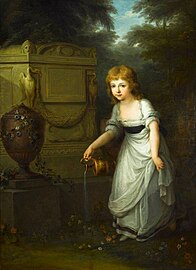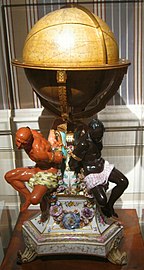King John III Palace Museum, Wilanów
 Interior of the Wilanów Palace | |
 Interactive fullscreen map | |
| Established | 1805 |
|---|---|
| Location | ul. Stanislawa Kostki Potockiego 10/16 Warsaw, Poland |
| Coordinates | 52°9′54.60″N 21°5′25.11″E / 52.1651667°N 21.0903083°E |
| Type | palace museum |
| Director | Paweł Jaskanis |
| Website | wilanow-palac.pl |
The Museum of King John III's Palace at Wilanów
History
The Wilanów Palace was first opened to the public in 1805, when the owners of the Palace, Stanisław Kostka Potocki and his wife Aleksandra Lubomirska created a museum, one of the first public museums in Poland.[2] In 1877 the museum was popularized by the publication entitled Wilanów. Album widoków i pamiątek... edited by Hipolit Skimborowicz and Wojciech Gerson.[2] This was followed in 1893 by a guide over the Palace and its collections.[2]
After the Second World War, the palace was renovated, and most of the collection, which had been stolen by
The Museum regularly organizes temporary exhibitions, conferences and seminars, conducts research, publishes books and organizes educational activities dedicated to both cultural and natural values of the Wilanów residence.[2] In September 2013 the museum was renamed as the Museum of King John III's Palace at Wilanów.[2]
Collection
The palace's collection started with its establishment by King John III Sobieski, who collected works of art and objects of everyday use.
Collection highlights
Painting
-
A girl with forget-me-nots, Lucas Cranach the Elder
-
Madonna and Child, Joos van Cleve
-
Apollo and two Muses, Pompeo Batoni
-
Portrait of Count Stanislas Potocki, Jacques-Louis David
-
Madonna and Child, Peter Paul Rubens
-
Portrait of Krystyna Potocka Watering Flowers on her Mother's Grave,Angelica Kauffmann
-
A Youth Lighting a Torch, Jan Lievens
-
Madonna and Child, Master of Frankfurt
Sculpture and Applied arts
-
Figurine of Shou Xing,Qing Dynasty
-
Bust of Marie Casimire Sobieska, Jacques Prou
-
Celestial globe, by Karl Christian Ludwig Adami
-
Tray with the triumph of John III, Johann Gottfried Holl
See also
- Poster Museum at Wilanów
Notes
- ^ "Contact". wilanow-palac.pl. Retrieved 9 March 2014.
- ^ a b c d e f g h i j k "Historia muzeum". wilanow-palac.pl. Retrieved 9 March 2014.
"Muzeum wilanowskie jest najstarszym polskim muzeum sztuki. Zostało założone w 1805 roku z inicjatywy ówczesnych właścicieli Aleksandry i Stanisława Kostki Potockich. (...) W 1877 roku spopularyzowało je wydawnictwo Hipolita Skimborowicza i Wojciecha Gersona „Wilanów. Album widoków i pamiątek..."; w 1893 roku wydano zaś przewodnik po pałacu w Wilanowie i jego kolekcji. Po drugiej wojnie światowej, na mocy reformy rolnej, majątek wilanowski przeszedł na własność państwa. Od końca lat 40. aż do połowy lat 50. rewindykowano zbiory z terenów Niemiec, Austrii i ZSRR. Od 1954 roku w pałacu i parku rozpoczęły się szeroko zakrojone prace rewitalizacyjne. (...) Uroczystego otwarcia pałacu w Wilanowie jako oddziału Muzeum Narodowego w Warszawie dokonano 10 września 1962 roku; dwa dni później, w rocznicę odsieczy wiedeńskiej, pałac udostępniono publiczności. W latach 70. XX wieku liczba odwiedzających pałac i ogrody wilanowskie sięgnęła 400 tysięcy osób rocznie. W 1983 roku w Wilanowie z okazji 300. rocznicy odsieczy wiedeńskiej zorganizowano jubileuszową wystawę „Chwała i sława Jana III w sztuce i literaturze". W 1995 roku Muzeum Pałac w Wilanowie stało się niezależną od Muzeum Narodowego instytucją, podległą Ministerstwu Kultury i Dziedzictwa Narodowego. Muzeum regularnie organizuje wystawy czasowe, konferencje i seminaria naukowe, prowadzi badania naukowe, wydaje książki naukowe i popularnonaukowe, organizuje zajęcia edukacyjne poświęcone zarówno wartościom kulturowym, jak i przyrodniczym wilanowskiej rezydencji. (...) We wrześniu 2013 roku muzeum zmieniło nazwę na Muzeum Pałacu Króla Jana III w Wilanowie.
- ^ a b c d e "History of the collection". wilanow-palac.pl. Retrieved 9 March 2014.
Already Jan III collected works of art and exquisite objects of everyday use. However, only a fraction of his collection – which included 6 paintings by Rembrandt, among others – survived to this day. Of the museum's current holdings, only a few works can be tied to the sponsorship of the first owner of the palace. With a significant dose of probability, this list would include two marvellous still lifes by Abraham van Mignon (...) Among his possessions, one may find excellent examples of European and Polish painting, goldsmithery, biscuits, craft, including an imposing collection of objects from the Far East. Potocki also sought out memorabilia of the first owners of the Palace, the Sobieski family. (...) The rich collection of paintings at the palace included works of Lucas Cranach, Peter Paul Rubens, Jan Lievens, Eustache le Sueur, Pompeo Batoni, Angelika Kauffmann, and Anton Graff, among others.
- ^ Wanda Drecka (1977). Na tropach obrazów ze zbiorów Jana III Sobieskiego (PDF). Studia Wilanowskie I. p. 135. Retrieved 9 March 2014.
- ^ "The most precious painting of the collection". wilanow-palac.pl. Retrieved 9 March 2014.
External links
- Website
- King John III Palace Museum, Wilanów within Google Arts & Culture
 Media related to Wilanów Palace at Wikimedia Commons
Media related to Wilanów Palace at Wikimedia Commons













